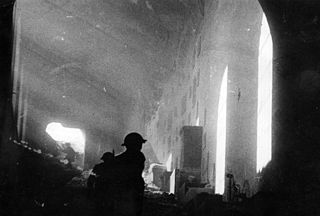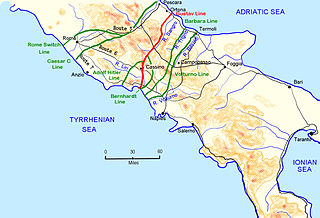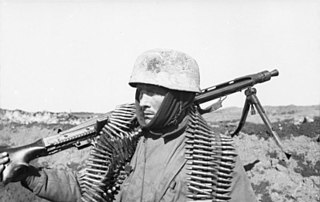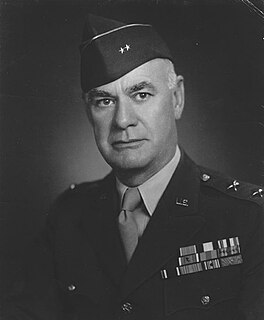Related Research Articles

The Battle of Monte Cassino was a costly series of four assaults by the Allies against the Winter Line in Italy held by Axis forces during the Italian Campaign of World War II. The intention was a breakthrough to Rome.

The Battle of Anzio was a battle of the Italian Campaign of World War II that took place from January 22, 1944 to June 5, 1944. The operation was opposed by German forces in the area of Anzio and Nettuno.

The Garigliano is a river in central Italy.

The Bernhardt Line was a German defensive line in Italy during the Italian Campaign of World War II. Having reached the Bernhardt Line at the start of December 1943, it took until mid-January 1944 for the U.S. Fifth Army to fight their way to the next line of defences, the Gustav Line. The line was defended by XIV Panzer Corps, part of the German Tenth Army.

The Winter Line was a series of German and Italian military fortifications in Italy, constructed during World War II by Organisation Todt and commanded by Albert Kesselring. The series of three lines was designed to defend a western section of Italy, focused around the town of Monte Cassino, through which ran the important Highway 6 which led uninterrupted to Rome. The primary Gustav Line ran across Italy from just north of where the Garigliano River flows into the Tyrrhenian Sea in the west, through the Apennine Mountains to the mouth of the Sangro River on the Adriatic coast in the east. The two subsidiary lines, the Bernhardt Line and the Hitler Line ran much shorter distances from the Tyrrehnian sea to just North East of Cassino where they would merge into the Gustav Line. Relative to the Gustav Line, the Hitler Line stood to the North-West and the Bernhardt Line to the South-East of the primary defenses.
The Battle of Cisterna took place during World War II, on 30 January–2 February 1944, near Cisterna, Italy, as part of the Battle of Anzio, part of the Italian Campaign. The battle was a clear German victory which also had repercussions on the employment of U.S. Army Rangers that went beyond the immediate tactical and strategic results of the battle.

The 36th Infantry Division ("Arrowhead"), also known as the "Panther Division", "Lone Star Division", "The Texas Army", or the "T-patchers", is an infantry division of the United States Army and part of the Texas Army National Guard. It was organized during World War I from units of the Texas and Oklahoma National Guard. As an all-Texas unit, it was called for service for World War II 25 November 1940, was sent to the European Theater of Operations in April 1943, and returned to the Texas Army National Guard in December 1945.
The Rapido is a short river which flows in the Italian province of Frosinone. The river is known for the Battle of the Rapido River, despite it actually occurring on the Gari River.

The II Corps was a corps-sized formation of the United States Army that was active in both World War I and World War II. It was originally formed and fought on the Western Front during World War I and was also the first American formation of any size to see combat in North Africa or Europe during World War II.

Mark Wayne Clark was a United States Army officer who saw service during World War I, World War II, and the Korean War. He was the youngest four-star general in the US Army during World War II.
The 2nd New Zealand Division, initially the New Zealand Division, was an infantry division of the New Zealand Military Forces during the Second World War. The division was commanded for most of its existence by Lieutenant-General Bernard C. Freyberg. It fought in Greece, Crete, the Western Desert and Italy. In the Western Desert Campaign, the division played a prominent role in the defeat of German and Italian forces in the Second Battle of El Alamein and the British Eighth Army's advance to Tunisia.

Cassino is a comune in the province of Frosinone, Central Italy, at the southern end of the region of Lazio, the last city of the Latin Valley.

General Sir Alfred Dudley Ward,, commonly known as Sir Dudley Ward, was a senior British Army officer who saw distinguished active service during the Second World War and later became Governor of Gibraltar. Serving as an ordinary soldier for three years before being sent for officer training in 1926, slow peacetime career progression saw Ward achieving the rank of captain only in 1937. However, the Second World War, which began just two years later, allowed him to demonstrate his high ability as both a staff officer and a commander of troops in the field. Receiving command of the 4th Infantry Division at the unusually young age of 39 years and 3 months, he led the division in Italy and Greece from 1944 to 1945. After the war ended in 1945, Ward went on to hold several staff and field appointments at the highest levels, including Deputy Chief of the Imperial General Staff and Commander-in-Chief of the British Army of the Rhine, retiring as a full general in 1965.

The 6th Armoured Division was an armoured division of the British Army, created in September 1940 during the Second World War. In October 1940, armoured regiments within the Division, such as the 2nd Lothian and Border Horse, were supplied with Matilda MkI.I tanks, then in May 1942 Crusader MkII tanks, in August 1942 Valentine Mk.V tanks and finally in October Crusader MKIIIs. In North Africa tankers were finally put on an almost equal footing to their Panzer counterparts when the M4A2 Sherman medium tank was added to their inventory by March 1943. In November/December 1942 The division participated in the Operation Torch assault landings in Bone, closest to the Axis Forces in all the Torch landings that stretched from Morocco to the Tunisian border. In November 1942 they saw their first action as part of V Corps of the British First Army, First Allied Army in the Tunisia Campaign. In March 1943, around the same time when most of the units had been supplied with American M4A2 Shermans, the Sixth Division came under IX Corp. After Tunisia, the Division participated in the Italian Campaign as part of the British Eighth Army and ended the war in Austria, again under the command of V Corps.

The Battle of San Pietro Infine was a major engagement from 8–17 December 1943, in the Italian Campaign of World War II involving Allied forces attacking from the south against heavily fortified positions of the German "Winter Line" in and around the town of San Pietro Infine, just south of Monte Cassino about halfway between Naples and Rome.
Thomas Edward McCall was a United States Army soldier and a recipient of the United States military's highest decoration—the Medal of Honor—for his actions during the Battle of Monte Cassino in World War II.

The Fallschirmjäger were the paratroop branch of the German Luftwaffe before and during World War II. They were the first German paratroopers to be committed in large-scale airborne operations. Throughout World War II, the commander of the branch was Kurt Student.

Major General Fred Livingood Walker was a highly decorated senior United States Army officer who served in both World War I and World War II and was awarded with the second highest military decorations in both wars, the Distinguished Service Cross. During World War I he commanded a battalion on the Western Front, fighting with distinction in the Second Battle of the Marne in July 1918. During World War II, Walker commanded the 36th (Texas) Infantry Division throughout its service in the Italian Campaign, from September 1943 until June 1944.

15th Panzergrenadier Division was a mobile division of the German Army in World War II

The Battle of Rapido River was fought from 20 to 22 January 1944 during one of the Allies' many attempts to breach the Winter Line in the Italian Campaign during World War II. Despite its name, the battle occurred on the Gari River.